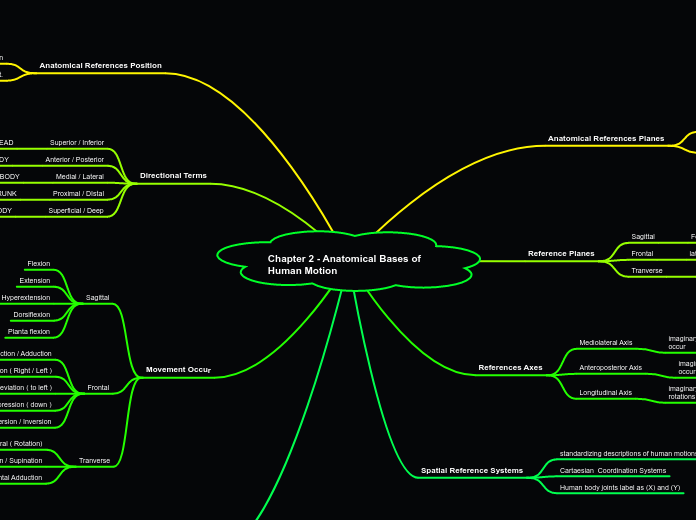Chapter 2 - Anatomical Bases of Human Motion
Anatomical References Planes
Planes
Two dimensional surface with an orientation
Cardial Planes
Three imaginary perpendicular reference planes that divide body into half
Reference Planes
Sagittal
Foward and backward movements occur
Frontal
lateral movement occur
Tranverse
rotational movement occur
References Axes
Mediolateral Axis
imaginary line around which SAGITTAL plane rotations occur
Anteroposterior Axis
imaginary line around which FRONTAL plane rotations occur
Longitudinal Axis
imaginary line around which TRANVERSE plane rotations occur
Spatial Reference Systems
standardizing descriptions of human motions
Cartaesian Coordination Systems
Human body joints label as (X) and (Y)
Anatomical References Position
Facing foward on standing position
Considered all segments of body movement.
Directional Terms
Superior / Inferior
HEAD
Anterior / Posterior
BODY
Medial / Lateral
MIDLINE BODY
Proximal / DIstal
TRUNK
Superficial / Deep
SURFACE OF BODY
Movement Occur
Sagittal
Flexion
Extension
Hyperextension
Dorsiflexion
Planta flexion
Frontal
Abduction / Adduction
Leg to inside / outside
Lateral flexion ( Right / Left )
Upper body
Radial Deviation ( to left ) / Ulnar Deviation ( to left )
Wrist
Elevation ( up ) / Depression ( down )
Shoulder
Eversion / Inversion
Foot print inside / outside
Tranverse
Medial / Lateral ( Rotation)
Pronation / Supination
Horizontal Abduction / Horizontal Adduction
Qualiative Analysis
Visual observation is the most commonly used approach.
Prerequisite Knowledge
Planning
PerformerAttire
Lighting Conditions
Background
Conducting The Analysis
